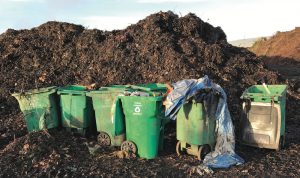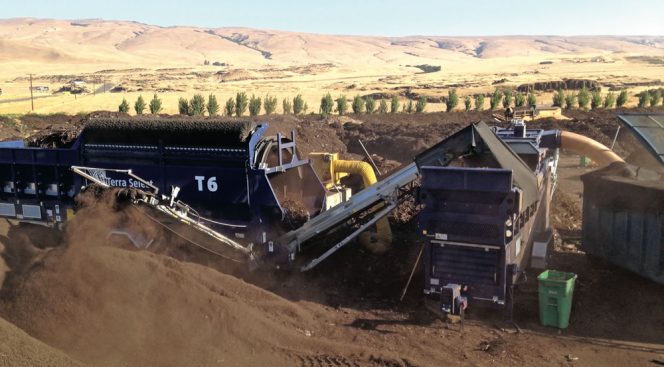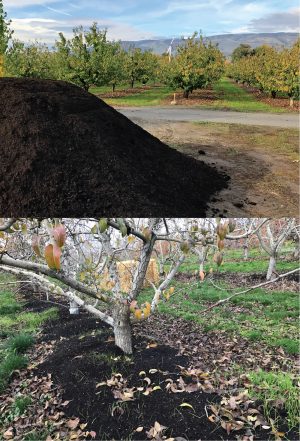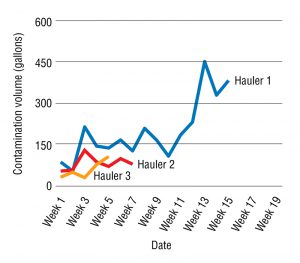Washington State composting facility uses multiple approaches to reduce contamination in residential and commercial food waste loads.
Craig Coker
BioCycle January 2017

Dirt Hugger has to meet the Washington Department of Ecology compost contaminant quality standard of less than 1% by weight total.
Photos courtesy of Dirt Hugger
Their first facility was built on leased space at an industrial park in The Dalles, Oregon, but had to move in 2014 across the Columbia River to Dallesport, Washington, as the park needed the land for expansion. Moving eight miles, their new site is a nine-acre parcel where they built a two-stage aerated composting operation, using a Green Mountain Technology system. Dirt Hugger takes in about 33,000 tons/year of pre and postconsumer food waste, residentially collected yard trimmings and food waste, commercial food waste (from restaurants, groceries, and schools), whole fruit waste, cherry sludge from fruit processing, beer waste and beer yeast waste (about 18,000 gallons/week), wood waste, and brush from the Columbia River Gorge region. The facility does not take any certified compostable bioplastics due to the difficulty of distinguishing between bioplastics and conventional petroleum plastics.
The Dirt Hugger site features a half-acre in-floor aeration system capable of positive/negative and reversing aeration. Active composting takes 14 days in an 8-ft high mass bed aerated static pile (ASP); curing is done in turned windrows on 4.5 acres of cement-stabilized soil. Curing piles are turned with a well-used Scat elevated face turner. The entire composting process takes 90 days. Leachate from the ASP in-floor aeration pad goes into a tank, while the remainder of the site drains to an aerated storm water pond.
Moisture is applied using a hose reel that feeds water to the turner, drawing from a 100,000-gallon fresh water pond on-site. This watering system is also used to introduce liquid brewery wastes to the active composting mass bed. About 13 percent of incoming feedstocks consist of yard trimmings that must be ground prior to composting; Dirt Hugger uses an outside contract grinder every two months. All other feedstocks, including food scraps, go straight into the aerated mass bed.

The variable speed fan on the wind sifter (above on right) was retrofitted to reduce product losses on the reject side from 50% to less than 20%.
Louis had Terra Select retrofit a variable-speed fan on the windsifter and was able to reduce product losses on the reject side from 50 percent down to less than 20 percent. The Windsifter enabless Dirt Hugger to meet the Washington Department of Ecology compost contaminant quality standard of less than one percent by weight total (not to exceed 0.25% by weight due to film plastic). Customers to date have been mostly farmers and back yard gardeners, so Dirt Hugger has not encountered customers, like the Departments of Transportation, in this two-state region, that have their own product quality specifications on contaminants.
Overs from the screen and the Windsifter are not recycled to the beginning of the composting process. “While we are able to remove 80 percent of the film plastic mechanically, all the higher-density plastics and glass that are in the overs have to be removed by hand, and there’s just too much volume to effectively do a good job,” notes Louis.

Orchards and agriculture are Dirt Hugger’s primary compost customers. The company is introducing custom blends based on soil needs in the orchards.
Feedstock Quality Control
Dirt Hugger receives food waste in 28-ton loads from the local transfer station, along with loads from various commercial haulers in the region. As it has little control over contamination, the company adopted a $75/load surcharge on badly contaminated loads, but also tried to use a little honey with the vinegar. “We went out of our way to create a good working relationship with the staff at the transfer station,” he adds. “They help us by actually refusing to load trucks headed our way with badly contaminated organics and will push those loads into the trash transfer trailers.” Dirt Hugger also distributes Hauler Feedstock Quality Reports (see sidebar) for each hauler it does business with as a way to open the dialogue about the importance of contamination control and also to buttress any surcharges it might impose.
“We are fortunate to have our feedstocks capture zone in two states with strong diversion programs and practices,” says Louis, “but there still are some structural issues we are wrestling with. For example, one of our customer municipalities adopted a weekly diversion program for food waste, but, at the same time, reduced the collection frequency for garbage from weekly to every other week. When their garbage cans filled up, they put the overflow in the organics carts.” Louis adds they have encountered several “wishful thinker” recyclers, who think much more should be composted than what they are allowed to put into the organics containers, as well as several recyclers who will put all their kitchen prep wastes in an empty plastic carrot or potato bag before putting the organics in the cart.
Source separation training of commercial and residential generators of food wastes is approached differently by region. For example, one region uses dedicated outreach coordinators while another publishes quarterly newsletters. “One program we launched to help the outreach coordinators is a ‘picking party’ where we invite the coordinators to tour the operation and then help pick plastic out of the screened compost. They are usually very surprised by the amount of plastic!”
Louis and Miller spent much of 2015 and 2016 optimizing their compost production operation. In 2017, Louis foresees a good year. “We are requesting a permit modification to increase our allowable tonnage to 50,000 tons per year, continue to optimize our production processes, and turn our attention to the burgeoning cannabis market in our area,” Lewis notes, due to legalization of marijuana in both Washington State and Oregon. “We have one product, a blend of compost and several other materials, we call ‘Skypuncher’ that sells for a very handsome price. We see a lot of potential growth in providing custom potting soils to that industry.”
Orchards and agriculture are still Dirt Hugger’s primary compost customers, which will continue. “What we hope to see is taking some of the lessons learned doing custom, high-end blends for cannibs and bring that into orchard management,” he notes. “We think there is great opportunity for value add and custom blending based on soil needs in orchards. And there are great efficiency gains in reduced application costs for the farmer by adding amendments to the compost prior to applying.”
Regarding contaminant management, Dirt Hugger is considering investing in a picking station to reduce contaminantion on the front-end. In general, though, it seems to have found the right balance between source separation training (the carrot), contamination surcharges (the stick), and state-of-the-art back-end contamination removal equipment (the safety net) to continue to make a high quality compost product.
Craig Coker is a Senior Editor at BioCycle and CEO of Coker Composting and Consulting, near Roanoke, VA. He can be reached at ccoker@jgpress.com.



 4th Quarter 2015
4th Quarter 2015






